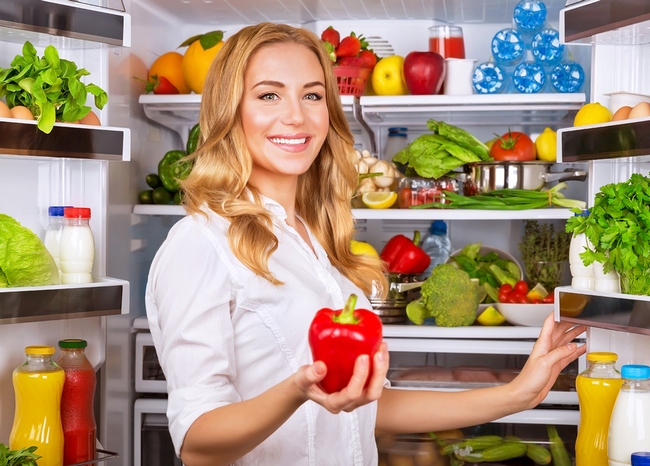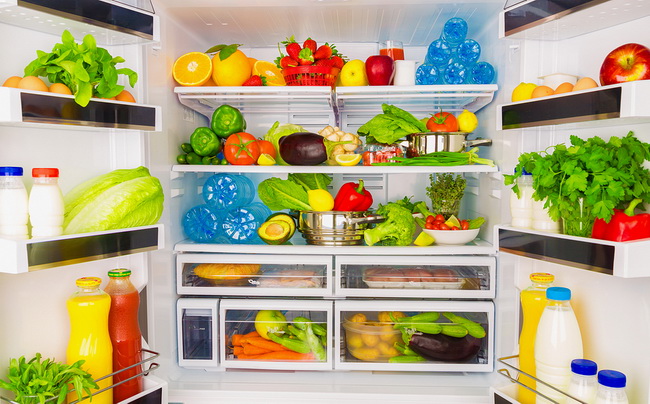- Make It Yourself Lavender Heart-Shaped Bath Bombs!
- 20 Things You Never Knew About “Down There”
- 12 Best Foods For Those Suffering From Arthritis Pain
- 12 Personal Hygiene Mistakes Almost Everyone Makes (Mom Never Told You About #4!)
- 15 Medicinal Plants And Herbs From The Cherokee People
- 12 Mind-Blowing Benefits Of Drinking Coconut Water During Pregnancy
- 12 Outstanding Winter Foods That Won’t Fatten You Up Like A Christmas Turkey
How To Store Your Expensive Fruits And Veggies So You Eat More And Waste Less

Photo credit: bigstock.com
You are probably doing your best to buy as many organic fruits and veggies as you can so you and your family will have less exposure to dangerous pesticides. As you know, organic produce is quite expensive, and it can be really disheartening to find that your $18 dollar bunch of organic grapes that you thought your family would devour in a couple days has gone bad.
Does it seem that your expensive produce is always going bad before you really get a chance to use it? Does the thought of having to go to the store every few days to get small amounts of produce seem kind of depressing? Who has time for that?!
Perhaps all you really need is to understand that some fruits and veggies produce gas, which causes them, and the produce near them, to rot faster.
Once you know which foods are prone to creating gas, you can store your produce properly so that it stays fresher longer.
Did you mother ever tell you that if you wanted pears or bananas to ripen more quickly, that you should put them into a paper bag? This is because these fruits emit ethylene gas. The gas causes the fruit to ripen more quickly.
That means that the old adage, “one bad apple spoils the whole bunch,” is really true!
Keep reading and find out which foods you should store where so that you can make the most of your expensive, organic produce.
1. Foods You Should Refrigerate
First, never wash your produce before you store it. Wait and wash it just before you are going to eat it, cook it, or cut it up. This will greatly eliminate the possibility of mold claiming your food first. The following foods should always be stored in the fridge:
- Zucchini
- Lima beans
- Yellow squash
- Leafy green veggies
- Summer squash
- Leeks
- Sprouts
- Mushrooms
- Spinach
- Okra
- Artichokes
- Beets
- Honeydew melons
- Brussels sprouts
- Green beans
- Cabbage
- Grapes
- Cantaloupe
- Cherries
- Celery
The following foods should be stored in the fridge, but only after they are completely ripe. If you put them in the fridge before this time, they will never fully ripen.
- Kiwifruit
- Avocados
- Nectarines
- Plums
- Peaches
- Pears
- Plums
Herbs and asparagus should be stored in the fridge in a glass of water.
2. Paper Bags
You can store all kinds of mushrooms and okra in a paper bag as it prevents light from reaching them.
Continue to Page 2

Photo credit: bigstock.com
3. Plastic Bags
The following foods can be safely stored in a plastic bag in the refrigerator:
- Radishes
- Broccoli
- Peas
- Carrots
- Lettuce (all kinds)
- Cauliflower
- Swiss chard
- Green onions
- Corn
- Cranberries
4. Berries
If at all possible, store berries in the refrigerator in a single layer, such as on a cookie sheet. This prevents the juice from spoiling other berries, and keeps mold from spreading from one berry to another. Remember to not rinse berries until you are ready to eat them. This helps to keep them from growing mold. If you don’t plan on eating them right away, rinse them, then freeze individually on a cookie sheet in the freezer. Put them in a container and store in the freezer until you are ready to use them.
5. On The Counter
The following items can be kept at room temperature, but out of direct sunlight unless you want them to ripen faster. If you can, move them around once every other day so that they are not resting in the same place day after day.
- Pineapple
- Apples
- Persimmon
- Bananas
- Peppers
- Tomatoes
- Papayas
- Basil
- Oranges
- Tangerines
- Cucumbers
- Mangos
- Lemons/Limes
- Eggplants
- Jicama
- Ginger
- Grapefruits
- Persimmon
- Watermelons
- Plantain
- Pomegranates
6. Cool and Dark Location
The following should always be kept in a cool, dark, dry place, such as a lower kitchen cabinet:
- Winter squash
- Acorn squash
- Sweet potatoes
- Butternut squash
- Spaghetti squash
- Garlic
- Onions
- Potatoes
- Shallots
- Pumpkins
However, please note that you should never store onions right next to potatoes as the ethylene gas will rot them much faster. Keep at least 12 inches of space between these two or store them in separate cabinets or containers.
READ ALSO: Top Fruits and Veggies You Can Regrow at Home Over and Over Again!
You might also want to eat more perishable foods first. For example, even under the best conditions, raspberries will never last as long as an orange. Eat things like berries, avocados, bananas, cherries, and leafy green vegetables first. Other items, such as cabbage, apples, celery, potatoes, and squash will keep much longer.
References:





























Gabe
Mar 24, 2016 at 9:15 am
Mostly I store my fruits and veggies in my tummy. 🙂
Marvin Zinn
Mar 22, 2018 at 7:24 am
I agree, but when I could get pears the owners did not want from the trees, I added honey, lemon juice, and cinnamon and canned more than 50 quarts a year until the electric and telephone companies paid the owners to cut down the trees.